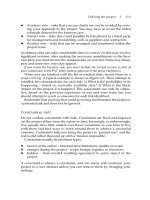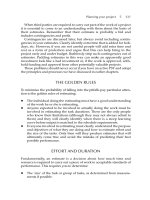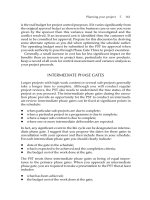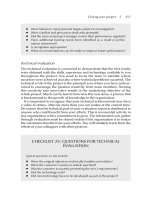Management a practical introduction 3rd kinicky chapter 03
Bạn đang xem bản rút gọn của tài liệu. Xem và tải ngay bản đầy đủ của tài liệu tại đây (353.18 KB, 47 trang )
Management
A Practical Introduction
Third Edition
Angelo Kinicki &
Brian K. Williams
Kinicki/Williams, Management: A Practical Introduction 3e ©2008, McGraw-Hill/Irwin
Chapter 3: The Manager’s Changing Work
Environment & Ethical Responsibilities
Doing The Right Thing
Inside Stakeholders
Outside Stakeholders
Ethical Responsibilities of Managers
Social Responsibilities of Managers
The New Diversified Workforce
Kinicki/Williams, Management: A Practical Introduction 3e ©2008, McGraw-Hill/Irwin
3.1 The Community Of Stakeholders
Inside The Organization
WHAT ARE INTERNAL STAKEHOLDERS?
Stakeholders are people whose interests are
affected by an organization’s activities
Internal stakeholders include
• employees,
• owners, and the
• board of directors
Kinicki/Williams, Management: A Practical Introduction 3e ©2008, McGraw-Hill/Irwin
3.1 The Community Of Stakeholders
Inside The Organization
Figure 3.1: The Organization’s Environment
Kinicki/Williams, Management: A Practical Introduction 3e ©2008, McGraw-Hill/Irwin
3.1 The Community Of Stakeholders
Inside The Organization
Today, forward-looking companies recognize that
employees can be the most important resource in the
organization, and that conflict between management and
employees can be detrimental to everyone’s stake in the
firm
Owners include all those who can claim an organization
as their legal property
The goal of owners is to make a profit
A company’s board of directors is elected by
stockholders to ensure the company is being run properly
The board of directors is responsible for helping to set
strategic goals and approve major decisions and salaries
for top management
Kinicki/Williams, Management: A Practical Introduction 3e ©2008, McGraw-Hill/Irwin
Chapter 3: The Manager’s Changing Work
Environment & Ethical Responsibilities
CLASSROOM PERFORMANCE SYSTEM
Which of the following is not an internal
stakeholder?
A) board of directors
B) employees
C) suppliers
D) owners
Kinicki/Williams, Management: A Practical Introduction 3e ©2008, McGraw-Hill/Irwin
Chapter 3: The Manager’s Changing Work
Environment & Ethical Responsibilities
CLASSROOM PERFORMANCE SYSTEM
Which of the following is not an internal
stakeholder?
A) board of directors
B) employees
C) suppliers
D) owners
Kinicki/Williams, Management: A Practical Introduction 3e ©2008, McGraw-Hill/Irwin
3.2 The Community Of Stakeholders
Outside The Organization
WHAT ARE EXTERNAL STAKEHOLDERS?
External stakeholders are those people or
groups in the organization’s external
environment that are affected by it
The external environment consists of the
• task environment and the
• general environment
Kinicki/Williams, Management: A Practical Introduction 3e ©2008, McGraw-Hill/Irwin
3.2 The Community Of Stakeholders
Outside The Organization
The task environment includes customers,
competitors, suppliers, distributors, strategic
allies, employee organizations, local communities,
financial institutions, government regulators,
special-interest groups, and mass media
Customers are those who pay to use an
organization’s goods or services
Competitors are people or organizations that
compete for customers or resources
A supplier is a person or organization that
provides supplies (raw materials, services,
equipment, labor, or energy) to other organizations
Kinicki/Williams, Management: A Practical Introduction 3e ©2008, McGraw-Hill/Irwin
3.2 The Community Of Stakeholders
Outside The Organization
Task Environment, cont.
A Distributor is a person or organization that helps
another organization sell its goods and services to
customers
Strategic allies describes the relationship between
two organizations that join forces to achieve
advantages neither can perform as well alone
Labor unions are usually associated with hourly
employees and professional associations usually
represent salaried workers
Local communities rely on companies for jobs, for tax
revenues, for financial support, and so on
Kinicki/Williams, Management: A Practical Introduction 3e ©2008, McGraw-Hill/Irwin
3.2 The Community Of Stakeholders
Outside The Organization
Task Environment, cont.
Start-ups often rely on credit cards to tide them
over, and established companies rely on financial
institutions like commercial banks, investment
banks, and insurance companies
Government regulators are stakeholders
because they are affected by organizations
Special interest groups are groups whose
members try to influence specific issues
Mass media is a powerful disseminator of both
positive and negative news about companies
Kinicki/Williams, Management: A Practical Introduction 3e ©2008, McGraw-Hill/Irwin
Chapter 3: The Manager’s Changing Work
Environment & Ethical Responsibilities
CLASSROOM PERFORMANCE SYSTEM
Which of the following is not part of the task
environment?
A) government regulators
B) unions
C) mass media
D) sociocultural forces
Kinicki/Williams, Management: A Practical Introduction 3e ©2008, McGraw-Hill/Irwin
Chapter 3: The Manager’s Changing Work
Environment & Ethical Responsibilities
CLASSROOM PERFORMANCE SYSTEM
Which of the following is not part of the task
environment?
A) government regulators
B) unions
C) mass media
D) sociocultural forces
Kinicki/Williams, Management: A Practical Introduction 3e ©2008, McGraw-Hill/Irwin
3.2 The Community Of Stakeholders
Outside The Organization
The general environment or macroenvironment includes
six forces: economic, technological, sociocultural,
demographic, political-legal, and international
Economic forces consist of the general economic
conditions and trends (unemployment, inflation, interest
rates, economic growth) that can affect a firm’s
performance
Technological forces are new developments in methods
for transforming resources into goods or services
Sociocultural forces are influences and trends in a
country’s, a society’s, or a culture’s human relationships
and values that may affect an organization
Kinicki/Williams, Management: A Practical Introduction 3e ©2008, McGraw-Hill/Irwin
3.2 The Community Of Stakeholders
Outside The Organization
The General Environment, cont.
Demographic forces are influences on an
organization arising from changes in the
characteristics of a population, such as age,
gender, or ethnic origin
Political-legal forces are changes in the way
politics shape laws and laws shape the
opportunities for, and threats to, an organization
International forces are changes in the
economic, political, legal, and technological
global system that can affect an organization
Kinicki/Williams, Management: A Practical Introduction 3e ©2008, McGraw-Hill/Irwin
Chapter 3: The Manager’s Changing Work
Environment & Ethical Responsibilities
CLASSROOM PERFORMANCE SYSTEM
How economic integration in Europe creates
opportunities and threats for American
companies is an example of which type of force?
A) economic
B) political-legal
C) international
D) sociocultural
Kinicki/Williams, Management: A Practical Introduction 3e ©2008, McGraw-Hill/Irwin
Chapter 3: The Manager’s Changing Work
Environment & Ethical Responsibilities
CLASSROOM PERFORMANCE SYSTEM
How economic integration in Europe creates
opportunities and threats for American
companies is an example of which type of force?
A) economic
B) political-legal
C) international
D) sociocultural
Kinicki/Williams, Management: A Practical Introduction 3e ©2008, McGraw-Hill/Irwin
3.3 The Ethical Responsibilities
Of You As A Manager
WHAT DO SUCCESSFUL MANAGERS NEED
TO KNOW ABOUT ETHICS?
Managers need to understand ethics, values, the four
approaches to ethical dilemmas, and how to promote ethics
Ethics are the standards of right or wrong that influence
behavior, while ethical behavior is behavior that is accepted
as “right” according to those standards
An ethical dilemma is a situation in which you have to
decide whether to pursue a course of action that may
benefit you or your organization but that is unethical or
even illegal
Kinicki/Williams, Management: A Practical Introduction 3e ©2008, McGraw-Hill/Irwin
3.3 The Ethical Responsibilities
Of You As A Manager
WHAT DO SUCCESSFUL MANAGERS
NEED TO KNOW ABOUT ETHICS?
Values are the relatively permanent
and deeply held underlying beliefs and
attitudes that help determine a person’s
behavior
Ethical dilemmas can take place when
a firm’s value system is challenged
Kinicki/Williams, Management: A Practical Introduction 3e ©2008, McGraw-Hill/Irwin
3.3 The Ethical Responsibilities
Of You As A Manager
WHAT ARE THE FOUR APPROACHES TO DECIDING
ETHICAL DILEMMAS?
1. According to the utilitarian approach, ethical behavior is
guided by what will result in the greatest good for the greatest
number of people
2. Under the individual approach, ethical behavior is guided
by what will result in the individual’s best long-term interests,
which ultimately is in everyone’s self-interest
3. According to the moral-rights approach, ethical behavior is
guided by respect for the fundamental rights of human beings
4. Ethical behavior under the justice approach is guided by
respect for impartial standards of fairness and equity
Kinicki/Williams, Management: A Practical Introduction 3e ©2008, McGraw-Hill/Irwin
3.3 The Ethical Responsibilities
Of You As A Manager
The recent frenzy of white-collar crime at
companies like Enron and World.com has raised
public and corporate awareness of corporate
ethics
In 2002, the Sarbanes-Oxley Act was passed to
establish requirements for proper financial
record keeping for public companies and
penalties for non-compliance
Laurence Kohlberg has suggested that
personal morals can be developed at three levels:
preconventional (follows the rules), conventional
(follows expectations of others), and
postconventional (guided by internal values)
Kinicki/Williams, Management: A Practical Introduction 3e ©2008, McGraw-Hill/Irwin
Chapter 3: The Manager’s Changing Work
Environment & Ethical Responsibilities
CLASSROOM PERFORMANCE SYSTEM
The relatively permanent and deeply held
underlying beliefs and attitudes that help
determine a person’s behavior are called
A) values
B) norms
C) attitudes
D) ethics
Kinicki/Williams, Management: A Practical Introduction 3e ©2008, McGraw-Hill/Irwin
Chapter 3: The Manager’s Changing Work
Environment & Ethical Responsibilities
CLASSROOM PERFORMANCE SYSTEM
The relatively permanent and deeply held
underlying beliefs and attitudes that help
determine a person’s behavior are called
A) values
B) norms
C) attitudes
D) ethics
Kinicki/Williams, Management: A Practical Introduction 3e ©2008, McGraw-Hill/Irwin
3.3 The Ethical Responsibilities
Of You As A Manager
HOW CAN ORGANIZATIONS PROMOTE ETHICS?
Firms can promote ethics in three ways:
1. Top management needs to support a strong ethical
climate
2. Companies can adopt a code of ethics – a formal
written set of ethical standards guiding an organization’s
actions
3. Companies can promote ethical behavior by rewarding
whistleblowers - employees who report organizational
misconduct to the public
Kinicki/Williams, Management: A Practical Introduction 3e ©2008, McGraw-Hill/Irwin
3.4 The Social Responsibilities Required
Of You As A Manager
WHAT ARE THE SOCIAL RESPONSIBILITIES OF
MANAGERS?
Social responsibility is a manager’s duty to take
the actions that will benefit the interests of society
as well as the organization
So, while ethical responsibility focuses on being
a good individual citizen, social responsibility
focuses on being a good organizational citizen
In the past, social responsibility was an
afterthought for companies, but today, many firms
believe it is critical to success
Kinicki/Williams, Management: A Practical Introduction 3e ©2008, McGraw-Hill/Irwin









